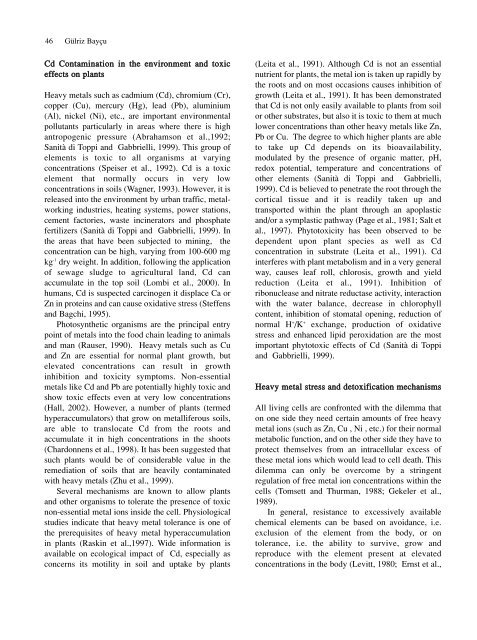Full Journal - Journal of Cell and Molecular Biology - Haliç Üniversitesi
Full Journal - Journal of Cell and Molecular Biology - Haliç Üniversitesi
Full Journal - Journal of Cell and Molecular Biology - Haliç Üniversitesi
Create successful ePaper yourself
Turn your PDF publications into a flip-book with our unique Google optimized e-Paper software.
46 Gülriz Bayçu<br />
Cd Contamination in the environment <strong>and</strong> toxic<br />
effects on plants<br />
Heavy metals such as cadmium (Cd), chromium (Cr),<br />
copper (Cu), mercury (Hg), lead (Pb), aluminium<br />
(Al), nickel (Ni), etc., are important environmental<br />
pollutants particularly in areas where there is high<br />
antropogenic pressure (Abrahamson et al.,1992;<br />
Sanità di Toppi <strong>and</strong> Gabbrielli, 1999). This group <strong>of</strong><br />
elements is toxic to all organisms at varying<br />
concentrations (Speiser et al., 1992). Cd is a toxic<br />
element that normally occurs in very low<br />
concentrations in soils (Wagner, 1993). However, it is<br />
released into the environment by urban traffic, metalworking<br />
industries, heating systems, power stations,<br />
cement factories, waste incinerators <strong>and</strong> phosphate<br />
fertilizers (Sanità di Toppi <strong>and</strong> Gabbrielli, 1999). In<br />
the areas that have been subjected to mining, the<br />
concentration can be high, varying from 100-600 mg<br />
kg -1 dry weight. In addition, following the application<br />
<strong>of</strong> sewage sludge to agricultural l<strong>and</strong>, Cd can<br />
accumulate in the top soil (Lombi et al., 2000). In<br />
humans, Cd is suspected carcinogen it displace Ca or<br />
Zn in proteins <strong>and</strong> can cause oxidative stress (Steffens<br />
<strong>and</strong> Bagchi, 1995).<br />
Photosynthetic organisms are the principal entry<br />
point <strong>of</strong> metals into the food chain leading to animals<br />
<strong>and</strong> man (Rauser, 1990). Heavy metals such as Cu<br />
<strong>and</strong> Zn are essential for normal plant growth, but<br />
elevated concentrations can result in growth<br />
inhibition <strong>and</strong> toxicity symptoms. Non-essential<br />
metals like Cd <strong>and</strong> Pb are potentially highly toxic <strong>and</strong><br />
show toxic effects even at very low concentrations<br />
(Hall, 2002). However, a number <strong>of</strong> plants (termed<br />
hyperaccumulators) that grow on metalliferous soils,<br />
are able to translocate Cd from the roots <strong>and</strong><br />
accumulate it in high concentrations in the shoots<br />
(Chardonnens et al., 1998). It has been suggested that<br />
such plants would be <strong>of</strong> considerable value in the<br />
remediation <strong>of</strong> soils that are heavily contaminated<br />
with heavy metals (Zhu et al., 1999).<br />
Several mechanisms are known to allow plants<br />
<strong>and</strong> other organisms to tolerate the presence <strong>of</strong> toxic<br />
non-essential metal ions inside the cell. Physiological<br />
studies indicate that heavy metal tolerance is one <strong>of</strong><br />
the prerequisites <strong>of</strong> heavy metal hyperaccumulation<br />
in plants (Raskin et al.,1997). Wide information is<br />
available on ecological impact <strong>of</strong> Cd, especially as<br />
concerns its motility in soil <strong>and</strong> uptake by plants<br />
(Leita et al., 1991). Although Cd is not an essential<br />
nutrient for plants, the metal ion is taken up rapidly by<br />
the roots <strong>and</strong> on most occasions causes inhibition <strong>of</strong><br />
growth (Leita et al., 1991). It has been demonstrated<br />
that Cd is not only easily available to plants from soil<br />
or other substrates, but also it is toxic to them at much<br />
lower concentrations than other heavy metals like Zn,<br />
Pb or Cu. The degree to which higher plants are able<br />
to take up Cd depends on its bioavailability,<br />
modulated by the presence <strong>of</strong> organic matter, pH,<br />
redox potential, temperature <strong>and</strong> concentrations <strong>of</strong><br />
other elements (Sanità di Toppi <strong>and</strong> Gabbrielli,<br />
1999). Cd is believed to penetrate the root through the<br />
cortical tissue <strong>and</strong> it is readily taken up <strong>and</strong><br />
transported within the plant through an apoplastic<br />
<strong>and</strong>/or a symplastic pathway (Page et al., 1981; Salt et<br />
al., 1997). Phytotoxicity has been observed to be<br />
dependent upon plant species as well as Cd<br />
concentration in substrate (Leita et al., 1991). Cd<br />
interferes with plant metabolism <strong>and</strong> in a very general<br />
way, causes leaf roll, chlorosis, growth <strong>and</strong> yield<br />
reduction (Leita et al., 1991). Inhibition <strong>of</strong><br />
ribonuclease <strong>and</strong> nitrate reductase activity, interaction<br />
with the water balance, decrease in chlorophyll<br />
content, inhibition <strong>of</strong> stomatal opening, reduction <strong>of</strong><br />
normal H + /K + exchange, production <strong>of</strong> oxidative<br />
stress <strong>and</strong> enhanced lipid peroxidation are the most<br />
important phytotoxic effects <strong>of</strong> Cd (Sanità di Toppi<br />
<strong>and</strong> Gabbrielli, 1999).<br />
Heavy metal stress <strong>and</strong> detoxification mechanisms<br />
All living cells are confronted with the dilemma that<br />
on one side they need certain amounts <strong>of</strong> free heavy<br />
metal ions (such as Zn, Cu , Ni , etc.) for their normal<br />
metabolic function, <strong>and</strong> on the other side they have to<br />
protect themselves from an intracellular excess <strong>of</strong><br />
these metal ions which would lead to cell death. This<br />
dilemma can only be overcome by a stringent<br />
regulation <strong>of</strong> free metal ion concentrations within the<br />
cells (Tomsett <strong>and</strong> Thurman, 1988; Gekeler et al.,<br />
1989).<br />
In general, resistance to excessively available<br />
chemical elements can be based on avoidance, i.e.<br />
exclusion <strong>of</strong> the element from the body, or on<br />
tolerance, i.e. the ability to survive, grow <strong>and</strong><br />
reproduce with the element present at elevated<br />
concentrations in the body (Levitt, 1980; Ernst et al.,

















